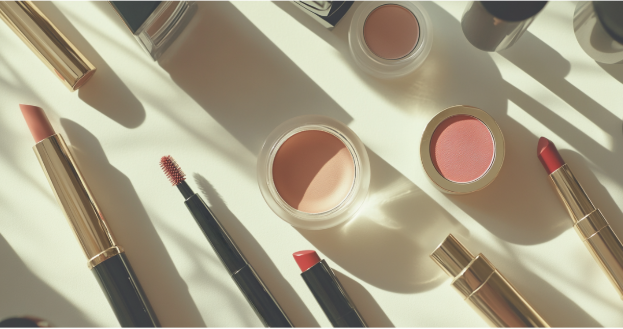Let’s be honest—we all have that one lipstick we just can’t let go of. Maybe it’s the perfect shade, or maybe we just can’t bear to part with it. But here’s the thing: makeup doesn’t last forever. Yep, even that pricey foundation or your favorite mascara has an expiration date. So, how do you know when it’s time to toss your products? And how can you make them last longer? Let’s break down makeup expiration dates and how to store beauty products properly.
How Long Is Too Long? Understanding Makeup Expiration Dates
Makeup isn’t just about looking good; it’s also about safety. Over time, products collect bacteria, especially those used near the eyes and mouth. This can lead to skin irritation, breakouts, or even infections.
The ingredients in makeup can also break down. This changes the texture, color, and performance. Plus, old makeup just doesn’t blend or sit right on the skin.
Most products have a little symbol on the packaging—a jar icon with a number like “6M” or “12M.” This tells you how many months the product is good for after opening it.
Makeup Expiration Dates: A Product-by-Product Guide

Hanging onto old makeup? Doing so might be doing more harm than good. Here’s how to know when it’s time to let go:
1. Mascara & Liquid Eyeliner: 3-6 Months ️
Why? The wand goes in and out, which introduces air and bacteria. This can cause eye infections.
Signs it’s bad: Clumpy texture, strange smell.
2. Foundation & Concealer: 6-12 Months (Liquid), 12-18 Months (Powder)
Why? Liquids are prone to bacteria growth, especially if applied with fingers.
Signs it’s bad: Separation in consistency, change in color or texture or weird smell.
3. Lipstick & Lip Gloss: 12-18 Months (Lipstick), 6-12 Months (Gloss)
Why? Products used on the mouth are exposed to bacteria easily.
Signs it’s bad: Changes in texture and smell; feels dry and waxy.
4. Eyeshadow & Powder Products: 12-24 Months ️✨
Why? Powders last longer because they don’t contain water. However, the brushes can introduce bacteria.
Signs it’s bad: Hard pan (shiny film), fading pigmentation, chalky texture.
5. Cream Blushes & Highlighters: 6-12 Months
Why? Cream products can grow bacteria faster than powders.
Signs it’s bad: rancid smell or visible mold (yes, it happens!).
6. Nail Polish: 1-2 Years
Why? Over time, nail polish thickens and separates.
Signs it’s bad: Thick, goopy texture that’s hard to apply smoothly.
How to Store Makeup for Maximum Shelf Life
Storing your makeup properly can help it last longer. Here’s how:
✅ Keep It Cool and Dry:
Humidity and heat speed up the breakdown of ingredients. To avoid quick deterioration, store makeup away from windows, radiators, and steamy bathrooms. A drawer or makeup organizer in a cool room is a great spot.
✅ Tightly Seal After Use:
Always close lids properly to prevent air from drying out the product or introducing bacteria.
✅ Clean Tools Regularly:
Brushes and sponges collect bacteria. Wash them weekly with gentle soap. Clean hands before applying makeup, too.
✅ Avoid Sharing Makeup:
Sharing makeup spreads bacteria, especially with products like mascara, eyeliner, and lipsticks.
✅ Don’t Add Water or Saliva to Revive Products:
Adding water or saliva to products introduces bacteria. If a product is drying out, it’s better to replace it.
Warning Signs Your Makeup Has Gone Bad
Sometimes, products go bad even before expiration, especially if not stored properly. Here’s what to look out for:
- Odd Smell: If it smells sour, musty, or just “off,” toss it.
- Texture Changes: Clumpy, thick, or separated products are no good.
- Color Shift: If the color has darkened, faded, or changed, it’s time to go.
- Skin Reactions: If you get redness, itchiness, or breakouts, stop using it.
The Science of Makeup Ingredients and Shelf Life
Ever wonder why some products last longer than others? It’s all about the ingredients.
1. Water-Based Products (Shorter Shelf Life)
Products like liquid foundations, mascaras, and creams contain water, which makes them more prone to bacteria growth. Bacteria love moisture, so these products expire faster.
2. Oil-Based Products (Moderate Shelf Life)
Lipsticks, cream blushes, and some liquid highlighters are often oil-based. Oils don’t grow bacteria as easily but can go rancid over time.
3. Powder-Based Products (Longer Shelf Life) ️
Powders, like eyeshadows and blushes, don’t contain water, so they last longer. However, oils from your skin or dirty brushes can contaminate them.
4. Natural and Organic Makeup (Shorter Shelf Life)
These products often lack strong preservatives, which means they can go bad faster—even if unopened. Always check their expiration dates carefully.
Understanding these differences helps you know which products to use up quickly and which ones can hang around a bit longer.
Quick Tips to Remember
- Label Your Products: Use a marker to write the open date on the packaging.
- First In, First Out: Use older products before newer ones.
- When in Doubt, Toss It Out: If you’re unsure, it’s better to be safe.
✨ Ready for a Makeup Detox?
At the end of the day, makeup is replaceable—your skin isn’t. It’s time to declutter your beauty stash, refresh your routine, and ensure your makeup works for you, not against you. Check your makeup expiration dates, toss the old, and keep your skin glowing with fresh, safe products!
FAQs About Makeup Expiration Dates
- Can I still use makeup after it expires?
Technically, yes—but it’s risky. Expired makeup can cause skin issues or infections. - Does unopened makeup expire?
Yes, though it lasts longer. Check for a shelf life symbol or expiration date on the packaging. - How do I make mascara last longer?
Don’t pump the wand—it pushes in air. Instead, swirl it gently. - Is it safe to keep makeup in the fridge?
For some products like eye creams, yes. But most makeup is fine at room temperature. - Can expired makeup cause acne?
Yes. Old products can harbor bacteria that trigger breakouts.


